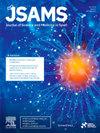肺癌患者癌症护理中的运动:叙述性综述。
IF 3
2区 医学
Q1 SPORT SCIENCES
引用次数: 0
摘要
目的:肺癌是全球第二大常见癌症,对患者的身体和心理造成严重影响。在这篇叙事性综述中,我们探讨了运动作为一种辅助疗法,在肺癌治疗前、治疗期间和治疗后对人们的健康问题所起的作用,并对运动处方和未来研究提出了建议:设计:叙事性基石综述:方法:进行叙述性综述,探讨运动在癌症治疗中对确诊肺癌患者的作用:结果:肺癌患者在治疗前、治疗中和治疗后参加运动项目后,体能、力量和生活质量均有改善。虽然在整个癌症治疗过程中,每周进行 2-5 次有氧(50%-100% 最大心率)和阻力(50%-85% 最大单次重复次数)综合训练是典型的处方,但目前很少有肺癌患者能够获得运动服务。最佳 "运动处方尚不明确,但很可能因人而异。当务之急是确定可耐受的起始运动量,肺癌及其治疗对呼吸系统的副作用,尤其是气短(呼吸困难),很可能会影响运动模式、持续时间和强度的初始最大阈值。迄今为止,对肺癌患者运动安全性的评估和报告很少,只有少数试验报告了运动安全性,但报告了运动安全性的试验也只报告了少量严重不良事件:结论:考虑到现有证据基础的优势和局限性,本文为医护人员在为肺癌患者开具运动疗法处方时提供了建议。本文章由计算机程序翻译,如有差异,请以英文原文为准。
Exercise in cancer care for people with lung cancer: A narrative synthesis
Objectives
Lung cancer is the second most common cancer diagnosed worldwide, resulting in significant physical and psychological consequences. In this narrative review, we explore the role of exercise as an adjunct therapy to counteract health issues experienced by people before, during and after treatment for lung cancer, and offer recommendations for exercise prescription and future research.
Design
Narrative cornerstone review.
Methods
A narrative review was conducted to explore the role of exercise in cancer care for people diagnosed with lung cancer.
Results
Improvements in fitness, strength and quality of life have been demonstrated in people with lung cancer following participation in exercise programmes before, during and post treatment. Whilst combined aerobic (50–100 % heart rate maximum) and resistance (50–85 % of 1 repetition maximum) training, 2–5 times per week across the cancer continuum is typically prescribed, few people with lung cancer currently access exercise services. ‘Optimal’ exercise prescription is unclear, although is likely individual-specific. The immediate priority is to identify a tolerable starting exercise dosage, with the side effects of lung cancer and its treatment on the respiratory system, particularly shortness of breath (dyspnoea), likely driving the initial maximum threshold for session mode, duration and intensity. To date, exercise safety for people with lung cancer has been poorly evaluated and reported — few trials report it, but those that do report small numbers of serious adverse events.
Conclusions
Recommendations for health professionals prescribing exercise therapy to people with lung cancer are provided, with consideration of the strengths and limitations of the current evidence base.
求助全文
通过发布文献求助,成功后即可免费获取论文全文。
去求助
来源期刊
CiteScore
7.40
自引率
10.00%
发文量
198
审稿时长
48 days
期刊介绍:
The Journal of Science and Medicine in Sport is the official journal of Sports Medicine Australia (SMA) and is an an international refereed research publication covering all aspects of sport science and medicine.
The Journal considers for publication Original research and Review papers in the sub-disciplines relating generally to the broad sports medicine and sports science fields: sports medicine, sports injury (including injury epidemiology and injury prevention), physiotherapy, podiatry, physical activity and health, sports science, biomechanics, exercise physiology, motor control and learning, sport and exercise psychology, sports nutrition, public health (as relevant to sport and exercise), and rehabilitation and injury management. Manuscripts with an interdisciplinary perspective with specific applications to sport and exercise and its interaction with health will also be considered.

 求助内容:
求助内容: 应助结果提醒方式:
应助结果提醒方式:


